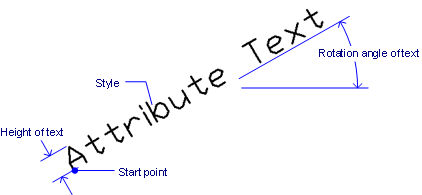Option
Description
Sets modes for the attributes:
Constant=Off
If On, uses the
default value; the user cannot change the value.
Type C, then press Enter to toggle
the attribute mode.
Invisible=Off
If On, hides the attribute; hidden attributes are not displayed nor printed. (Hidden attributes can be displayed with the AttDisp command.)
Type I, then press Enter to toggle the attribute mode.
Preset=Off
If On, inserts attributes without prompting the user; the attributes can be changed later with the AttEdit command.
Type P, then press Enter to toggle the attribute mode.
Verify=Off
If On, forces the user to enter the value a second time; this helps to ensure the value is entered correctly.
Type V, then press Enter to toggle the attribute mode.
Lock position=Off
If On, locks the position of the attribute within the block reference.
Unlocked attributes can be moved relative to the rest of the block using grip editing and multiline attributes can be resized.
Type L, then press Enter to toggle the attribute mode.
Multiple lines=Off
If on, uses multiline text instead of single line text.
Type M, then press Enter to toggle the attribute mode.
<done>
Press Enter to continue with the remainder of the command.
Specifies the tag of the attribute; this is the name by which BricsCAD identifies the attribute. You can use up to 255 letters, numbers, and punctuation.
Specifies the user prompt; this is displayed at the command prompt when the attribute is later inserted in the drawing. You can leave this field blank; BricsCAD uses the tag as the prompt during attribute insertion.
Specifies the default value; this is displayed in angle brackets, like <360>. As with other defaults, the user need only press Enter to accept this value.
If the Multiple lines mode is ON, you are prompted:
Next line or <done>: Type the next line of the Mtext or press Enter to stop.

Specifies the style and justification of the text:
-
Style specifies the text style; enter the name of a style present in the drawing.
-
Align aligns the text between two points; the text height is adjusted to maintain its aspect ratio.
-
Fit aligns the text between two points; the text height is maintained.
-
Center centers the text's baseline on the pick point.
-
Middle centers the text on the pick point.
-
Right right justifies the text.
-
Justify accesses additional justification options.
-
Start point left justifies the text.
Specifies the height of the attribute text, unless overridden by the text style or justification. Enter a value, or pick two points to indicate the height.
Specifies the rotation angle of the rotation text. Enter a value, or pick two points to indicate the angle relative to the positive x axis.